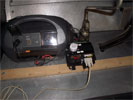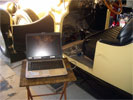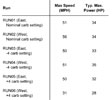
Measuring Baseline Performance
With a Data Logger
 The GPS antenna of a DL1 makes an achronistic addition to Bugsby's hood |
Jump to:
DL1 Data Logger
Readers of his AtomAnt pages will know that Lynn owns a Race Technology DL1 Data Logger. This amazing little device uses a dual-axis accelerometer and GPS (Global Positioning System) to record position and acceleration (as well as other data) on a memory card for subsequent analysis on a computer. The DL1 analysis software can compute a number of interesting performance parameters, and it will compute power developed by the engine if one knows the weight of the vehicle. Using Bugsby's measured weight, Lynn proceeds to mount the DL1 to make some baseline measurements of the car's performance.
 The DL1 and power supply
The DL1 and power supply
|
 Lynn sets up the DL1 using a laptop
Lynn sets up the DL1 using a laptop
|
Lynn temporarily mounts a strip of wood across the floor boards of Bugsby, bolting the DL1 to this strip. The DL1 is built to run off the 12V power from the auxiliary power socket (cigarette lighter) of a car. This presents a minor problem since Bugsby doesn't have a such a socket. Besides it's power system is 6V and not 12V. Fortunately Lynn has a portable Xantrex Powerpack 400 portable power supply. This handy device (light, 115V AC inverter output, 12V DC outlet, air compressor) is built around a rechargeable 12V battery. It's a simple matter to plug the DL1 into this portable powerpack.
Baseline Performance Summary
The following table summarizes the six speed runs that were made this day. Lynn made separate runs in both an eastward and westward direction along the same road. This road has a slight upward slope in the eastern direction (slight downward slope in the western direction). As the speedometer isn't currently operating, Lynn aborted the run after reaching a fairly fast speed as he didn't want to get into any extended discussions with the local constabulary. In fact, after the third run, Lynn sees a Livermore Police Department cruiser patroling the neighboring industrial park. This makes Lynn a little more cautious of his maximum speed on subsequent runs. On the sixth run, a part of the accelerator linkage pops apart half way through the run while in second gear, aborting the run at 31 MPH. Had Lynn known that he was this close, he would liked to have pushed Bugsby to 60 MPH so he could get a 0-60 MPH performance estimate. Some literature that he has says that the Speedster can do 0-60 in 30 s, although it doesn't appear that Bugsby is anywhere near ready to accomplish this, yet.
 Summary of the six performance runs
Summary of the six performance runs
|
 A plot for RUN02
A plot for RUN02
|
While Bugsby has been running somewhat better after recent valve and carburator adjustments, Lynn wondered if different carb settings might result in significant improvements in performance. So for runs three and four Lynn set the carb four notches leaner than his nominal setting, while for runs five and six he set the carb four notches richer. Looking at the summary data, it does not appear that these different carb settings made any real difference in the performance.
Lynn isn't satisfied yet with the performance of the engine and a compression test seems to indicate that there may be some issues with the seating of the valves. Nonetheless, these series of performance runs will provide a baseline against which Lynn can judge future tuning efforts.
NACC Horsepower Rating
According to this 1924 Autocar website, here's some background on the NACC horsepower rating. "*N.A.C.C. Horsepower. This formula was used by several manufacturers and license offices in many cities. It represents a comparitive horsepower rating for vehicles. Originally adopted by the A.L.A.M. (Association of Licensed Automobile Manufacturers) which later became the N.A.C.C. (National Automobile Chamber of Commerce). It is not an engineering formula and does not accurately represent the power of an engine. For instance, the stroke of an engine is not included in the formula."
Contact
 with your comments or questions
with your comments or questionsCopyright © 2018 Lynn Kissel
Last updated: May 24, 2009